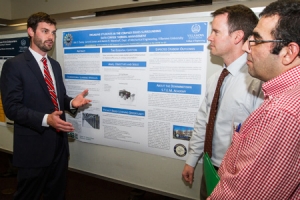Engineering Research Enriches STEM Education

Eric Daney, Dr. Aaron Wemhoff, Khosrow Ebrahimi (L-R)
Usually, it's a back-to-school ritual for students, not teachers. But this fall, Eric Daney, a physics teacher at Downingtown STEM Academy, turned the desks on his 9th graders by telling them how he spent his summer vacation. More important, he strategized how to incorporate the knowledge he had acquired into their curriculum. Thanks to a grant from the National Science Foundation, Daney had capitalized on the opportunity to learn firsthand about research focused on making data centers greener. His premier summer "classroom": the College of Engineering's Center for Energy-Smart Electronic Systems (ES2).
An NSF Industry/University Cooperative Research Center, the ES2 Center comprises government, industry and university partners (including Villanova) that use their expertise to address one of the hottest issues in engineering. The consortium's mission is to develop systematic methodologies for efficiently operating electronic systems by controlling resources and managing workloads to achieve optimal energy consumption. Daney was thrilled to be in on the action.
In the College's state-of-the-art Multidisciplinary Design Lab and Laboratory for Advanced Thermal and Fluids Systems, Daney observed, conferred with and assisted faculty, postdocs and students as they tackled the challenges of making data centers more energy-efficient.
Mentoring him were three faculty experts: Gerard "Jerry" Jones, PhD, '72 COE, senior associate dean for Graduate Studies and Research; Aaron Wemhoff, PhD, assistant professor, Mechanical Engineering; and Alfonso Ortega, PhD, associate vice president for Research and Graduate Programs, and the James R. Birle Professor of Energy Technology. Dr. Ortega is also Villanova’s lead in the NSF consortium.
Daney soon discovered that keeping up with the research team required him to have his bags packed. In July, he flew to San Francisco, where several Villanovans presented papers at InterPACK 2013, the American Society of Mechanical Engineers' international conference on the packaging and integration of electronic and photonic microsystems. As he moved from session to session, Daney never stopped taking notes on what he would share with his students.
"Looking at it through the lens of a scientist, I kept thinking, 'I'm learning cool stuff for my class lessons!' From the perspective of a teacher, I focused on the communication skills I need to impart to students so they’ll be ready one day to speak at a conference or in a boardroom." In addition to emphasizing these skills throughout the year, Daney plans to cover the technical content with his students in their course work on energy.
Daney's experience sums up perfectly the goal of the grant from the NSF’s Research Experiences for Teachers in Engineering and Computer Science program: to involve K-12 STEM teachers in the research at universities that partner with NSF so that they can share their new knowledge through age-appropriate classroom activities with their students. This holistic approach excites both Daney—who serves as the K-12 science curriculum leader for Downingtown School District—and his mentors, for it exposes young people to a world and careers paths about which they may have given little thought.
"Our relationship with Eric has enabled him to translate the complex issues surrounding efficient data center thermal management into a format that high school students can understand," Dr. Wemhoff says. "Students" awareness of the issues will inspire many of them to pursue engineering in college."
The partnership forged with Downingtown STEM Academy creates a unique bridge between the College of Engineering's cutting-edge research labs and K-12 classrooms. It offers yet another testimony of how diverse and robust is the College's portfolio of outreach programs that promote young people's interest in science, technology, engineering and mathematics. For example, five students from Downingtown STEM Academy spent a week on campus this summer shadowing engineering faculty. The College's innovative efforts to help the country achieve STEM priorities reflect Villanova’s commitment to excellence in education, service to the community and desire to share its expertise through personal and institutional collaborations—which for Daney, is the real momentum builder.
"My biggest takeaway this summer was making connections," he says. "Education is about people, personalities and relationships. I’m now connected with people who will continue to build a network around education—people who see the value of these programs and of preparing students to fill the STEM-related jobs of the future."
